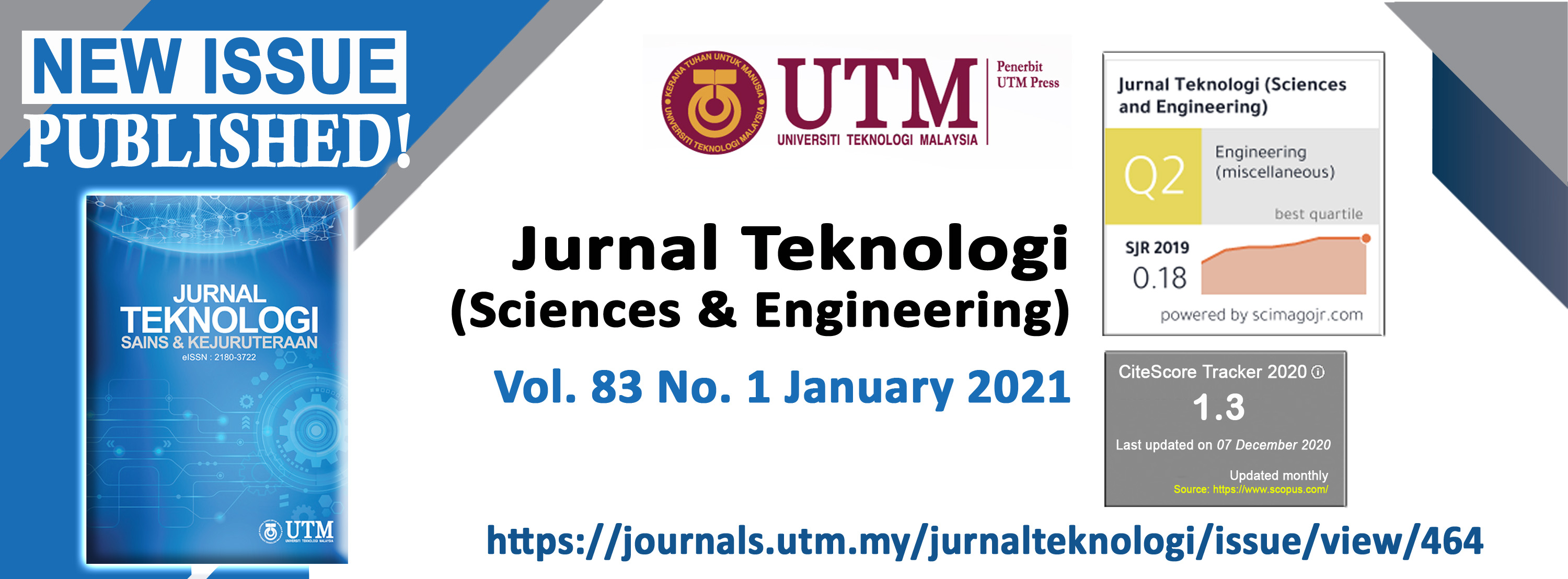NOVEL COMPOSITE OF SILVER-BACTERIAL CELLULOSE (Ag-BC) FROM SIWALAN SAP (Borassus flabellifer) AND ITS ANTIBACTERIAL ACTIVITY
DOI:
https://doi.org/10.11113/jurnalteknologi.v83.14363Keywords:
Bacterial cellulose, silver, composite, antibacterial activity, Borassus flabelliferAbstract
Recently, a wound healing from natural composite with excellent properties is in a high demand. In this study, a novel composite of bacterial cellulose made from Siwalan sap (Borassus flabellifer) was achieved. Siwalan is a common plant in Java Island of Indonesia and the application is very limited for beverage only. This study aims to determine the effect of the AgNO3/NaBH4 concentration ratio in the development of Ag-BC composites and its antibacterial properties from Siwalan sap. Ag-BC composites were prepared by impregnating the silver solution into the BC matrix through the reduction process with NaBH4. Characterization of Ag-BC composites conducted using Fourier Transform Infrared Spectroscopy (FTIR), Scanning Electron Microscopy (SEM), and Energy Dispersive X-ray (EDX). Antibacterial assay was performed using disc diffusion method against Salmonella typhimurium (Gram-negative) and Staphylococcus aureus (Gram-positive) bacteria. The characterization of Ag-BC composite shows the nanostructure of BC with a length of fiber around 35-60 nm in width. The SEM-EDX micrograph showed that silver particles were impregnated into the BC matrix. Antibacterial activity test results showed that the Ag-BC composite had the ability to inhibit the bacteria S. typhimurium and S. aureus with good inhibition. This result showed the potential application of Ag-BC composite from Siwalan plant as a natural material for medical and pharmaceutical purpose, especially as an antibacterial agent.
References
Almaida I F, Pereira T, Silva N H C S, Gomes F P, Silvestre A J D, Freire C S R, Sousa Lobo J M, and Costa P C 2014 Bacterial cellulose membranes as drug delivery systems: An in vivo skin compatibility study Eur. J. Pharm. Biopharm. 86. 332–336
Brown, R.M., Willson. J.H., Richardson, C.L.,1976. Cellulose biosynthesis in Acetobacter xylinum: Visualization of the site of synthesis and direct measurement of the in vivo proses. Proceedings of the National Academy of sciences of the United States of America. 73(12): 4565-4569.
Chaloupka K, Malam Y & Seifalian AM . 2010. Nanosilver as a new generation of nanoproduct in biomedical applications. Journal Trends Biotechnol , 28: 580–588.
Halib, N., Amin, M.C.I.M., dan Ahmad, I., 2012. Physicochemical properties and characterization of Nata de coco from local food industries a source of cellulose. Sains Malaysiana, 41(2): 205-211
He, J., Kunitake, T., dan Nakao, A. (2003). Facile in situ synthesis of noble metal nanoparticles in porous cellulose fibers. Chemistry of Materials, 15: 4401-4406.
Indrianingsih, W., Rosyida, V.T., Jatmiko, T.H., Prasetyo, D.J., Poeloengsih, C.D., Apriyana, W., Nisa, K., Nurhayati, S., Hermawan., Darsih, C., Pratiwi, D., Suwanto, A., Ratih, D., 2017. Premilinary Study On Biosynthesis And Characterization Of Bacteria Cellulose Films From Coconut Water. IOP Conf. Series: Earth and Enviromental Science., doi:10.1088/1755-1315/101/1/012010
Indrianingsih, A.W., Maryana, R., Rosyida, V.T., Apriyana, W., Jatmiko, T.H., Hayati, S.N., 2017. Antibacterial Activity Of Silver-Modified Bacterial Cellulose Produced From Coconut Water for Wound Dressing Application. .Chemistry Research Journal, 2(6): 251-261
Kurosumi,A., Sasaki, C., Yamashita, Nakamura, Y., 2009. Utilization of various fruit juice as carbon source for production of bacterial cellulose by Acetobacter xylinum NBRC 13693. Carbohydrate Polymer. 76 (2): 333-335
Maneerung, T., Tokura, S., Rujiravanit, R., 2007. Impregnation of silver nanoparticles into bacterial cellulose for antimicrobial wound dressing. Carbohydrate Polymers (72): 43-51
Mardiyah,S., 2017. Pengaruh Lama Pemanasan Terhadap Kadar Alkohol Pada Nira Siwalan (Borassus flabellifer). The journal Of Muhamadiyah Medical Laboratory Technologist, 2(1): 99-15
Maulana, M.I., Syahbanu, I., Harlia., 2017. Sintesis dan karakterisasi material konduktif film komposit polipirol (Ppy)/selulosa bakteri. JKK, 6(3): 11-18
Mohite, Bhavana & Patil, Satis V. 2016. In situ development of nanosilver-impregnated bacterial cellulose for sustainable released antimicrobial wound dressing. Biomater Funct Mater, 14( 1): 53 – 58
Pal,S., Nisi, R., Stoppa, M., Licciulli, A., 2017. Silver-Functionalized Bacterial Cellulose as Antibacterial Membrane for wound-Healing Applications. American Journal Chemical Sociaty, (2): 3632-3639
Prasad, S.B. 2013. Current Understanding of Synthesis and Pharmacological Aspects of Silver Nanoparticles. American Journal of Phytomedicine and Clinical Therapeutics, 1(7): 536-547.
Salasa, D., Aritonang, H., Kamu, V.S., 2016. Sintesis Nanopartikel Perak (Ag) dengan Reduktor Natrium Borohidrat (NaBH4) Menggunakan Matriks Nata de coco. Chem. Prog, 9(2): 40-47
Shidlovskiy, I.P., Shumilova, A.A., dan Shishatskaya, E.I., 2017. Preparation and caracterization of Bacterial Cellulose Composites with Silver Nanoparticles. Journal of Siberian Federal University, Biologi, 10(2): 255-264
Volova, T.G., Shumilova, A.A., Shidlovskiy, I.P., Nikolaeva, E.D., 2018. Antibacterial properties of film of cellulose composites with silver nanoparticles and antibiotics. Polymer Testingi, 65: 54-68
Wu, J., Zheng, Y., Song, W., Luan, J., Wen, X., Wu, Z., Chen, X., Wang, Q., Guo, S., 2013. In situ synthesis of silver-nanoparticles/bacterial cellulose composites for slow-released antimicrobial wound dressing. Carbohydrate Polymers.
Yang W, Shen C, Ji Q, An H, Wang J, Liu Q & Zhang Z. 2009. Food storage material silver nanoparticles interfere with DNA replication fidelity and bind with DNA. Nanotechnology (20): 0957–4484.
Yunita, M., Hendrawan, Y., Yulianingsih, R., 2015. Analisis Kuantitatif Mikrobiologi Pada Makanan Penerbangan (Aerofood ACS) Garuda Indonesia Berdasarkan TPC (Total Plate Count) dengan Metode Pour Plate. Jurnal Keteknikan Pertanian Tropis dan Biosistem,3(3): 237-248. DOI : http://dx.doi.org/10.11113/jt.v79.9987
Downloads
Published
Issue
Section
License
Copyright of articles that appear in Jurnal Teknologi belongs exclusively to Penerbit Universiti Teknologi Malaysia (Penerbit UTM Press). This copyright covers the rights to reproduce the article, including reprints, electronic reproductions, or any other reproductions of similar nature.
















